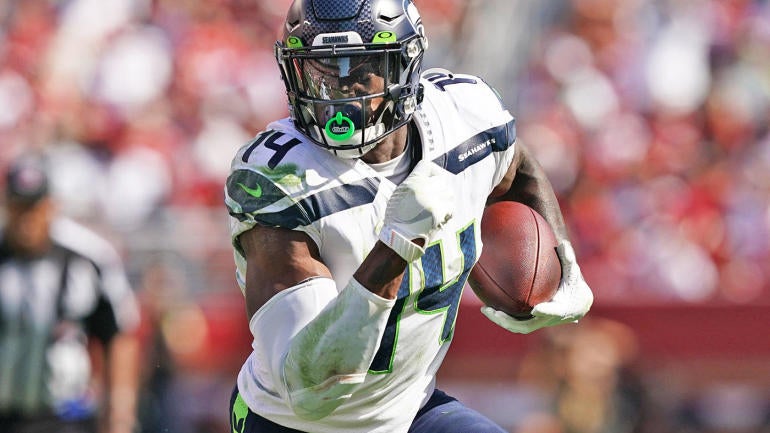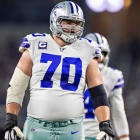
Not too long ago, the $20 million-per-year mark was the Holy Grail for wide receivers. That isn't the case anymore. There were four $20 million-per-year wideouts (Keenan Allen, Amari Cooper, DeAndre Hopkins and Julio Jones) when the offseason began. The number has more than doubled to nine despite the Titans releasing Jones. By the time the 2022 regular season starts, the number will easily be in double figures.
The Chargers got the ball rolling by signing Mike Williams to a three-year, $60 million contract with $40 million fully guaranteed before the March 8 deadline teams had to designate franchise players. Williams' franchise tag would have been $18.816 million. The Chargers are the only NFL team with two $20 million-per-year wideouts. Allen signed a four-year contract extension averaging $20.025 million per year with $50 million of guarantees during the 2020 preseason.
The Buccaneers struck next with Chris Godwin. Conventional wisdom suggested Godwin would hit the open market when he tore the ACL and MCL in his right knee late in the 2021 regular season but he was franchised for a second straight year at $19.18 million this time around. He signed a nearly identical three-year, $60 million deal to Williams' shortly after quarterback Tom Brady unretired.
The next big move was the Raiders acquiring wide receiver Davante Adams, who was designated as a franchise player, from the Packers for 2022 first- and second-round picks. Adams signed a five-year, $140 million contract with the Raiders. There are $65.67 million in guarantees, of which $42.75 million was fully guaranteed at signing in the deal. The maximum value of Adams' contract is $141.25 million because of an annual $250,000 Pro Bowl incentive.
D.J. Moore, who was scheduled to play 2022 under an $11.116 million fifth-year option, signed a three-year, $61.884 million extension averaging $20.628 million per year, of which $41.6 million was fully guaranteed at signing.
Signability became an issue for the Chiefs with wide receiver Tyreek Hill after the Adams deal. He was dealt to the Dolphins for five draft picks: 2022 first-, second- and fourth-round picks in addition to 2023 fourth- and sixth-round picks. Miami gave Hill a four-year, $120 million extension, which has $72.2 million in guarantees, with $52.535 million fully guaranteed at signing.
The Bills remedied Stefon Diggs being underpaid last week after outperforming the five-year, $72 million extension (worth up to $81 million through salary escalators) he signed with the Vikings in 2018. Diggs led the NFL with 127 receptions and 1,535 receiving yards in 2020 following a trade from the Vikings to the Bills. He received a four-year, $96 million extension with $70 million in guarantees where $47.985 million was fully guaranteed at signing. Incentives reportedly make the deal worth up to $104 million.
Diggs' $24 million-per-year extension average signifies that the inflated values of the Adams and Hill deals for bragging rights are being minimized by teams in negotiations. On paper, Adams became the NFL's highest-paid wide receiver (by average yearly salary) ahead of Hopkins, who signed a two-year, $54.5 million extension with the Cardinals in 2020. Adams' five-year, $140 million deal is really $67.5 million over three years because there's $72.5 million in the last two years. He isn't going to play 2025 and 2026 for $36.25 million each when he's 32 and 33 years old. Hill has the distinction of being the NFL's first $30 million-per-year non-quarterback with his four-year, $120 million extension. Realistically, it's a three-year extension for $75 million because of $45 million in 2026, the final contract year.

Pick Six Newsletter
Crafted By The Best NFL Experts
Get the day's big stories + fun stuff you love like mock drafts, picks and power rankings.
Thanks for signing up!
Keep an eye on your inbox.
Sorry!
There was an error processing your subscription.
Four wide receivers in the 2019 draft class are in line to top the $20 million-per-year mark. Second-round picks A.J. Brown (Titans), DK Metcalf (Seahawks) and Deebo Samuel are each scheduled to make $3.986 million in their 2022 contract year thanks to being selected to the Pro Bowl on the original ballot during their first three NFL seasons. Third-round pick Terry McLaurin (Commanders) is slated to earn $2.79 million this season.
Teams will attempt to downplay, if not dismiss, the inflated $28 million and $30 million-per-year values of the Adams and Hill deals in these contract discussions. A trend of opting for a shorter term has developed with the wide receivers who hadn't signed a lucrative veteran contract. Godwin, Moore and Williams gave up three new contract years. The idea is to try to get as many "bites of the apples" as possible with the salary cap set to explode in the coming years thanks to new media rights deals reportedly worth $113 billion over 11 years and an influx of gambling revenue.
McLaurin hasn't been to the Pro Bowl but compares favorably statistically with the second-round picks. During McLaurin's three seasons in Washington he has practically averaged 74 receptions, 1,030 receiving yards and five touchdown catches without quarterback stability. Brown has essentially averaged 62 catches for 998 yards and eight touchdowns in a run-oriented offense featuring 2020 NFL Offensive Player of the Year Derrick Henry. Newly acquired Carson Wentz should be the best quarterback McLaurin has had in Washington.
Typically, negotiations of contract extensions are over the amount of compensation in a contract excluding what a player was scheduled to make, the new money, and the number of new contract years. McLaurin may want to borrow a page from what appears to have occurred with Moore.
The four-year, $72 million contract (worth up to $84 million through incentives) with $37 million in guarantees Christian Kirk received from the Jaguars seemingly was an important data point for Drew Rosenhaus, Moore's agent. Moore is under contract over the next four years for $73 million, which is $1 million more than the base value of Kirk's deal. If McLaurin got the same $73 million over four years as Moore, it would be a three-year extension averaging $23,403,333 per year -- $70.21 million in new money since his current 2022 salary is $2.79 million.
A franchise tag analysis could also enter the equation. The 2023 wide receiver number should be in the $20 million range. A second franchise tag in 2024 at an NFL Collective Bargaining Agreement-mandated 20% raise would be around $24 million. The $22 million average of two projected franchise tags might be a fair approximation of a McLaurin deal.
CAA Sports' Tory Dandy is going to play a significant role in the additional developments in the wide receiver market because he represents Brown, Metcalf and Samuel. Godwin and Williams also have Dandy as their agent. Dandy probably won't be able to dictate which player signs first because teams can have their own timetables for doing new deals. For example, the Seahawks usually don't get extensions done until the mid-June mandatory minicamp is approaching at the earliest. Whichever of the three goes first will likely set the market for the other two just like in Williams' and Godwin's cases.
The 49ers, Seahawks and Titans have indicated that the wide receivers aren't available in a trade. That might be subject to change if there is sticker shocker and a legitimate concern about being able to reach an agreement. The optimal time to make a trade would be within the next two weeks before the 2022 NFL Draft begins on April 28 so current draft capital could be acquired.
The Seahawks reportedly turned down the 10th overall pick in this year's draft from the Jets for Metcalf, who set a franchise record with 1,303 receiving yards in 2020. The Jets made a serious push to acquire Hill and give him a new contract. Presumably, the Jets would be willing to pay Metcalf or another comparable wide receiver obtained via trade in the same neighborhood as the Dolphins did Hill. Because of these developments, Metcalf has ammunition to ask the Seahawks for a Hill-type contract or a trade to a team that will. Metcalf, though, has stated he wants to remain in Seattle.
Samuel, who is coming off a breakout season, is the most intriguing of the four because of his versatility, which should add to his value. He earned All-Pro honors while emerging as one of the NFL's most dangerous offensive weapons. Samuel led the league with 18.2 yards per catch. He caught 77 passes for 1,405 yards with six touchdowns. Samuel was also a threat out of the backfield. He performed at a Pro Bowl level as a running back when the 49ers started utilizing him in that capacity because of injuries. Samuel rushed for 365 yards on 59 carries (6.2 yards per carry) and scored eight touchdowns on the ground. His 1,770 yards from scrimmage (combined rushing and receiving yards) were third in the NFL last season.
Niners general manager John Lynch called Samuel a foundational piece shortly after the 49ers lost the NFC Championship Game to the Rams. Samuel unfollowing the 49ers on social media and scrubbing references to the team on Instagram has led to speculation that he could be traded. Wanting more than Hill's $25 million-per-year value of his contract, not the inflated $30 million average, can be justified because of his unique skill set.
There is one other wide receiver who could be in line for a contract in this salary stratosphere. According to Gary Klein of the Los Angeles Times, the Rams intend to reward Cooper Kupp this offseason. Whether that means a new deal, or just some sort of contract adjustment, remains to be seen. There are two years remaining on Kupp's contract, like with Diggs before his new deal. Kupp has also outperformed his contract. He signed a three-year, $47.25 million extension (worth a maximum of $49.5 million through salary escalators) in 2020.
Kupp had a season for the ages in 2021. He nearly broke the single-season record for receptions and receiving yards. Kupp's 145 receptions and 1,947 receiving yards are both second on the single-season list. He also topped the NFL with 16 receiving touchdowns. Kupp became the first player to win the receiving triple crown since Steve Smith in 2005. He also earned NFL Offensive Player of the Year honors and capped his historic season by being named MVP of Super Bowl LVI. Kupp has an excellent case for becoming the league's highest-paid wide receiver based on his performance last season.

















